四年级英语上册 Unit 3教案 上海新世纪版
四年级上册英语教案-unit3 Are you happy 牛津上海版
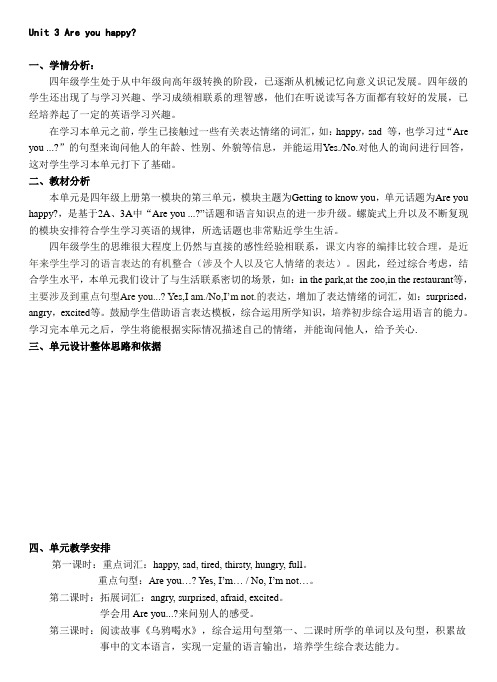
Unit 3 Are you happy?一、学情分析:四年级学生处于从中年级向高年级转换的阶段,已逐渐从机械记忆向意义识记发展。
四年级的学生还出现了与学习兴趣、学习成绩相联系的理智感,他们在听说读写各方面都有较好的发展,已经培养起了一定的英语学习兴趣。
在学习本单元之前,学生已接触过一些有关表达情绪的词汇,如:happy,sad 等,也学习过“Are you ...?”的句型来询问他人的年龄、性别、外貌等信息,并能运用Yes./No.对他人的询问进行回答,这对学生学习本单元打下了基础。
二、教材分析本单元是四年级上册第一模块的第三单元,模块主题为Getting to know you,单元话题为Are you happy?,是基于2A、3A中“Are you ...?”话题和语言知识点的进一步升级。
螺旋式上升以及不断复现的模块安排符合学生学习英语的规律,所选话题也非常贴近学生生活。
四年级学生的思维很大程度上仍然与直接的感性经验相联系,课文内容的编排比较合理,是近年来学生学习的语言表达的有机整合(涉及个人以及它人情绪的表达)。
因此,经过综合考虑,结合学生水平,本单元我们设计了与生活联系密切的场景,如:in the park,at the zoo,in the restaurant等,主要涉及到重点句型Are you...? Yes,I am./No,I’m not.的表达,增加了表达情绪的词汇,如:surprised,angry,excited等。
鼓励学生借助语言表达模板,综合运用所学知识,培养初步综合运用语言的能力。
学习完本单元之后,学生将能根据实际情况描述自己的情绪,并能询问他人,给予关心.三、单元设计整体思路和依据四、单元教学安排第一课时:重点词汇:happy, sad, tired, thirsty, hungry, full。
重点句型:Are you…? Yes, I’m… / No, I’m not…。
四年级第一学期Module3 Unit3教案
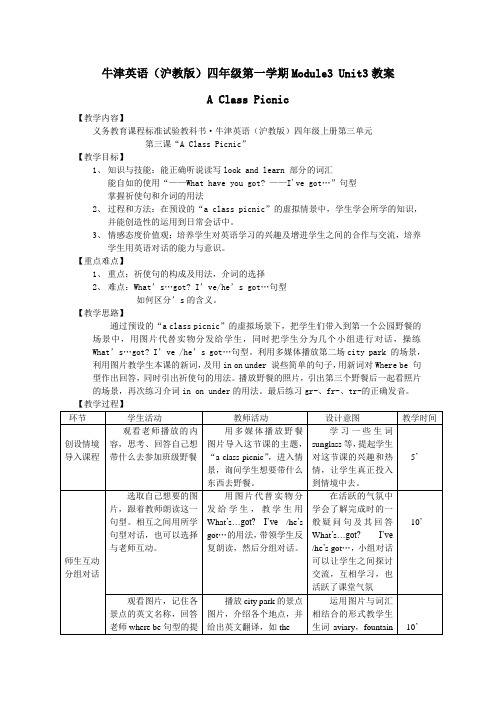
牛津英语(沪教版)四年级第一学期Module3 Unit3教案A Class Picnic【教学内容】义务教育课程标准试验教科书·牛津英语(沪教版)四年级上册第三单元第三课“A Class Picnic”【教学目标】1、知识与技能:能正确听说读写look and learn 部分的词汇能自如的使用“——What have you got? ——I've got…”句型掌握祈使句和介词的用法2、过程和方法:在预设的“a class picnic”的虚拟情景中,学生学会所学的知识,并能创造性的运用到日常会话中。
3、情感态度价值观:培养学生对英语学习的兴趣及增进学生之间的合作与交流,培养学生用英语对话的能力与意识。
【重点难点】1、重点:祈使句的构成及用法,介词的选择2、难点:What’s…got? I’ve/he’s got…句型如何区分’s的含义。
【教学思路】通过预设的“a class picnic”的虚拟场景下,把学生们带入到第一个公园野餐的场景中,用图片代替实物分发给学生,同时把学生分为几个小组进行对话,操练What’s…got? I’ve /he’s got…句型。
利用多媒体播放第二场city park 的场景,利用图片教学生本课的新词,及用in on under 说些简单的句子,用新词对Where be 句型作出回答,同时引出祈使句的用法。
播放野餐的照片,引出第三个野餐后一起看照片的场景,再次练习介词in on under的用法。
最后练习gr-、fr-、tr-的正确发音。
【教学过程】环节学生活动教师活动设计意图教学时间创设情境导入课程观看老师播放的内容,思考、回答自己想带什么去参加班级野餐用多媒体播放野餐图片导入这节课的主题,“a class picnic”,进入情景,询问学生想要带什么东西去野餐。
学习一些生词sunglass等,提起学生对这节课的兴趣和热情,让学生真正投入到情境中去。
小学英语沪教版四年级上册《Unit 3 Are you happy》教案

Module 1 Getting to know youUnit 3 Are you happy?教材分析本课是教材Module 1 Unit 3的教学设计。
本单元的语言功能项目是To revise vocabulary and expressions to describe “Are you happy?”.主要话题是The students are able to use the key words correctly,本课内容贴近学生的生活和学习实际,为学生操练对话创设了一个真实的语言情景,有利于学生在比较接近实际的情景中听听说说,从而培养他们运用英语进行交际的能力。
教学目标【知识目标】1. To revise vocabulary and expressions to describe “Are you happy?”2. To guess meaning from context.3. The students are able to use the key words correctly.【能力目标】To use the sentences in context.【情感目标】利用多种游戏或活动形式培养学生对英语学习的浓厚兴趣。
教学重难点【教学重点】The students are able to use the key words correctly.【教学难点】通过阅读活动,引导学生通过阅读抓住关键信息,了解故事大意,通过角色扮演,让学生巩固和运用本单元所学核心词汇和句型。
课前准备Tape recorder, Multimedia.教学过程Step 1. Warm up1. Listen and sayT: What do you know about “Are you happy?”?Look at the pictures on P610 and PPT. Talk about “Are you happy?”Encourage them to talk about the topic. To introduce them to the topic.2. ListeningPlay the listening materials, stop when necessary. And then check the answers.To train the students’ ability of catching the information of the listening materials.Step 2. Presentation1. Look and learnLead them to read and explain the “Are you happy?”e.g: I’m happy, because I have a new kite.To review the related knowledge.2. Make and say(1) Learn the rules in P11.(2) Finish the exercise on P11 and group work to work out the usage method of the “Are you happy?”(3) Walk around to exam the situation and check the answers for them.(4) List the method of for them. To develop their interest and lead them to the conclusion.Step 3. Practice1. Say and actLet the students look PPT and act the scene. To make them get familiar with the details of the text and train their ability of saying and reading.2. Learn the letters(1) Learn the letters in P13.(2) List the letters for them. To develop their interest and lead them to the conclusion.Step 4. Homework1. Dictation.2. Use the new words to make sentences on your own or check them in a dictionary.。
牛津上海版(试用本)四年级上册英语Module 3 Unit 3 In the shop教案

Module 3 Unit 3 In the shop教案教材分析一、教材内容【单元目标】知识与技能1、知晓字母组合sm-, sp-和st-在单词词首的发音,并能正确朗读相关儿歌。
2、能用a packet of sweets, a loaf of bread,a bowl of noodles, a bar of chocolate, a packet of biscuits, a bottle of water等核心词汇来表达物品的数量和名称,并能正确书写;了解在英语中可以用…of…来表示名词的数量。
3、能用How much is it /are they? 等核心句型来询问物品的价格,并做出正确应答。
4、会列出、介绍购物清单;学会简单的购物对话;并能读懂、表演故事Panda’s Glasses Shop。
文化与情感1、养成制定购物清单的习惯,学会根据自己的需要合理购买物品;2、体会购物的便捷,学会与人交际的礼仪,享受购物过程中的乐趣。
学习策略在课堂交流中,学会倾听同伴和老师之间的交流,学会提取信息,积极与他人交流,并能借助自制学具学习语段。
【语用任务】能根据自己的需要列购物清单,并能进行简单的购物对话,语音正确,表达较流利。
【课时话题】【课时目标】内容整合一、第二课时教学文本Shopping in the supermarketKitty and her mum are in the supermarket. They want to buy some food and drinks for the welcome party.Mum:Here’s the drinks section.Kitty:Wow!Mum:What do you want for your welcome party, Kitty?Kitty:Let me have a look. I want five bottles of water.Mum:OK.Kitty:Jill likes orange juice best. May I have a bottle of orange juice, Mum?Mum:All right. How much is it?Kitty:It’s four yuan. Oh, look! Three bottles of orange juice are only nine yuan.Mum:Really? Let’s have three bottles of orange juice.Kitty:Great!They buy some water and juice at the drinks section.At the bakery section, they buy some bread. At the snacks section, they buy some biscuits, sweets and chocolate.Kitty:Thank you, Mum.Mum:You’re welcome. Have a happy party with your friends.Kitty has all the things on the shopping list. She is so happy.第二课时教学设计一、重点、难点1、重点: 能在情境中,根据购物清单扮演Kitty和Mum进行购物对话。
(沪教牛津版)四年级英语上册教案Module3Unit3Period1-2
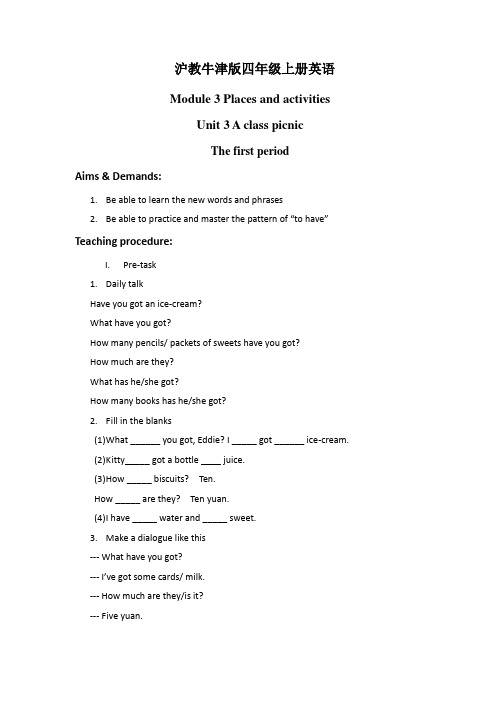
沪教牛津版四年级上册英语Module 3 Places and activitiesUnit 3 A class picnicThe first periodAims & Demands:1.Be able to learn the new words and phrases2.Be able to practice and master the pattern of “to have”Teaching procedure:I.Pre-task1.Daily talkHave you got an ice-cream?What have you got?How many pencils/ packets of sweets have you got?How much are they?What has he/she got?How many books has he/she got?2.Fill in the blanks(1)W hat ______ you got, Eddie? I _____ got ______ ice-cream.(2)K itty_____ got a bottle ____ juice.(3)H ow _____ biscuits? Ten.How _____ are they? Ten yuan.(4)I have _____ water and _____ sweet.3.Make a dialogue like this--- What have you got?--- I’ve got some cards/ milk.--- How much are they/is it?--- Five yuan.II.While-task1.T: It’s sunny toda y. I want to go out for a picnic. Do you wanna go with me? Learn: picnica class picnichave a picnicgo out for a picnic2.T: What do you need for a picnic?Learn: camera 照相机digital camera 数码相机What brand of (digital) camera do you know?( I know Canon digital camera.)Learn: sunglassesa pair of sunglassesa pair of shoes/ trousers/ glasses/ pants/ socks/ gloves…Learn: sketch-book 速写本Who has got a sketch-book?3.T: Miss Fang and her students also want to go out for a picnic. Now they are talking about what they have got. Let’s listen to the tape, and then tell me who has what?Listen to the tape of “Look and read”, then answer the questions:What has Eddie/ Peter/ Danny/ Miss Fang got?4.Read the dialogue after the tapeUnderstand:I’ve got = I have got Miss Fang’s got = Miss Fang has gothe’s got = he has got she’s got = she has gotXX’s got= XX has gotwhat’s XX got = what has XX got5.Ask and answer according to the pictureS1: Wh at’s Kitty got in her bag?S2: She’s got… What’s Eddie got?S1: He’s got…III.Post-task1.Do a surveyS1: What have you got in/ on your…?S2: I’ve got …S3: What’s XX (S2) got in/ on his/ her …?S1: He’s/ she’s got …2.Rewrite the sentence(1) Danny has got a hat.否定句:Danny _______ got a hat.一般疑问句:______ Danny _____ a hat?划线提问:_____ ______ Danny ______?_______ Danny _____?用I 代替Danny: I ______ _______ a hat.(2) I’ve got some butter.否定句:I _____ _____ _____ butter.一般疑问句:____ ____ got _____ butter?划线提问:_____ _____ _____ got?3.Homework(1)Copy and recite the new words and phrases(2)Listen and read P30(3)Do the exercises ( III/2)The Second Period Aim & Demands:1. Be able to review the prepositions2. Be able to learn the new words and expressions3. Be able to learn and master the patterns of “Where’s / are …”Teaching procedureI. Pre-task1. Daily talk:What have you got in your bag ?What’s he got in his hand ?What’s she got on her desk ?Have you got a sketch-book ?Has Eddie got a camera ?How many sunglasses have you got?How much are they?Where are your sunglasses now ?Where’s your bag ?2. Read the following prepositionsin , on , under , near , in front of , behind , beside, between3. Fill in the blanks with the prep(1) I see a camera ____ the table.(2) My pencil is _____ my hand.(3) Please sit ______ Tom and Peter.(4) There are a lot of flowers _____ the tree.(5) Miss Fang is _______ the blackboard.(6) What have you got ____ your bed? A pair of shoes.II. While-task1. T: We know, Miss Fang and her students have a lot of things, such as crisps, camera, sunglasses , sketch-books and so on. They are ready for their picnic. They want to go to City Park.Learn: city 城市City ParkCompare: country city town countryside2. What’s in City Park? ( Imagine)Maybe there is/ are… in City Park.Learn: playgroundin / on the playgroundWhat can you do in/on the playground?Learn: pondWhat can you see in the pond?Learn: fountainWhere can you see a fountain?Learn: plant houseWhat’s in the plant house?Learn: aviaryWhat’s in the aviary?3. T: Look, Miss Fang and her students are in City Park now. They see a lot of things indifferent places. Let’s listen, where ar e they?Listen and then answer the questions:Where are the birds?Where’s the fountain?Where’s Alice?4.Show the questions and the answers, then readUnderstand the usage of where and pay attention to the following:Where are the bird s? Th ey’re in the aviary.Where’s the fountain? It’s under the tree.Where’s Alice? She’s on a swing.III. Post-task1. Ask and answer in pairs according to the hints and the picture on P312. Complete the dialogue--- Where’s Danny?--- ______ on the playground.--- What’s he doing there?--- He ___________ a rope.--- ______ ____ Alice and Kitty?--- _________ on the slide.---Let’s go and play with them.---OK.3. Homework(1) Listen and read P31(2) Complete the above dialogue(3) Copy and recite the new words and phrases。
沪教版四年级英语第一学期试用本教案Unit 3 How do you feel_教案2
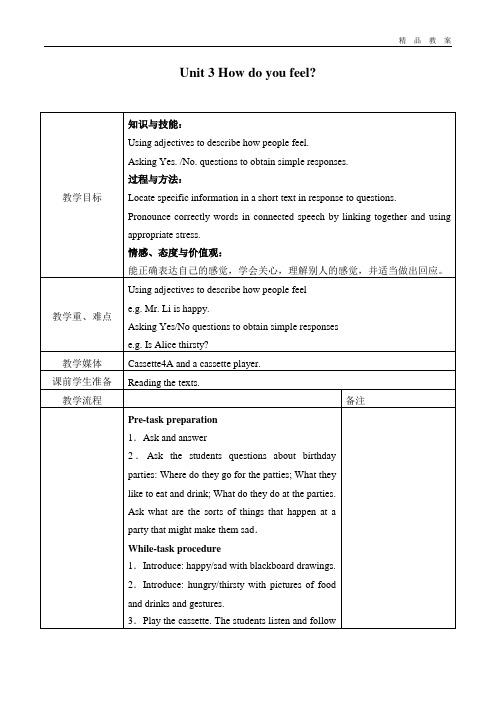
教学目标
知识与技能:
Using adjectives to describe how people feel.
Asking Yes. /No. questions to obtain simple responses.
过程与方法:
Locate specific information in a short text in response to questions.
5.Distribute Photocopiable.The students read the questions and tick Yes or No.
6.Encourage the students to say why the characters are happy/sad etc.
In pairs, the students practise: Ask and answer. Students may develop the tick-list into written response, e.g. Yes, Mr.Li is happy.
a)Read: The party.
b)Ask students to decide how eachcture clues.
4.Write: happy/sad/hungry/thirsty on the board, with simple gestures to demonstrate each feeling.
Pronounce correctly words in connected speech by linking together and using appropriate stress.
新世纪大学英语第四册教案unit 3 Knowing Yourself

New Century College EnglishBookⅠ《新世纪大学英语》第一册公共外语教研部第二教研室UNIT 3 Knowing Y ourselfUnit 3 Knowing Yourself1. T eaching Objectives:Students will be able toA.Grasp the main idea and structure of the text:B.Learn some techniques in writing;C.Master the key language points and grammatical structures in the text:D.Conduct a series of reading, listening, speaking and writing activities related to the themeof the unit.2. Time Allotment:1st Period: Pre-reading Activities (Warm-up questions; Think and speak; Background information )While-reading ( Global-reading: understanding Text A as a whole ) 2nd Period: While-reading Activities ( Detailed reading: learning Text A in detail )3rd Period: While-reading Activities ( Detailed reading continued)4th Period: Post-reading Activities ( Summarize the useful experessions inText A; Deal with Task 3 in the text book; Check Ss’understanding of Text B; Some after-textexercises;Home Assignment)3. T eaching Procedures:3.1 Pre-reading ActivitiesStep 1 Warm-up questions:Sit in groups of threes or fours and discuss the following questions.1. Do you know what your strengths and weaknesses are? Think of concrete examples or situations in which your strengths and weaknesses are demonstrated.2. Can you describe your best friend’s persenality? Do you think he/she would agree with you?3. ―Babies are born with a blank slate. It is the environment that shapes their personality.‖ What do you think of this statement?4. What personality traits do you dislike most? Why?5. Is there any aspect of your personality that you would like to develop or change? Method: Using task-based language teaching method, communicative approach, andaudio-lingual method.Step 2. Think and speak:1. What are the differences between the words ―character, personality, feature, trait‖?2. Which words can we use to describe people’s personality traits?Reference answers are:understanding (宽容的)warm-hearted(热心肠的)considerate (善解人意的)talkative (健谈的,爱说话的)hot/quick-tempered(性情暴躁的)faithful (忠实的,可靠的)considerate (体贴的,考虑周到的)emotional (多情善感的)brave (勇敢的)thoughtful (深思熟虑的)introverted(内向的)extroverted(外向的)independent (独立的)patient (有耐心的)broad-minded (心胸开阔的)easy-going(随和的)energetic(精力旺盛的)humorous(幽默的)optimistic(乐观的)pessimistic(悲观的)generous(大方的,慷慨的)mean (吝啬的)sensitive(敏感的)timid(胆怯的)aggressive (好斗的)Method: Using CAI, PPT, task-based language teaching method, communicative approach, audiolingual method.Step 3. Background information:1. Johari Window ModelThe Johari Window, named after the first names of its inventors, Joseph Luft and Harry Ingham, is one of the most useful models describing the process of human interaction. A four-paned “window”, as illustrated above, divides personal awareness into four different types, as represented by its four quadrants (象限): Arena, Façade, Blind Spot and Unknown. The lines dividing the four panes are like window shades, which can move as an interaction progresses. The Arena quadrant represents things that both I know about myself, and that you know about me. The Blind Spot quadrant represents things that you know about me, but that I am unaware of. The Façade (表面,外观) quadrant represents things that I know about myself, that you do not know. The Unknown quadrant represents things that neither I know about myself, nor you know about me. Training workshops using this model have been conducted for participants to find out about themselves through self-reflection and through feedback from others.2. Personality StructuresSigmund Freud used the Ego, the Id and the Superego to signify three aspects of personality development. The Id, in simple terms, refers to our basic instincts; the Ego, on the other hand, is related to the adjustment to reality; while the Superego is concerned with the moral conscience. These three aspects of our mind are in constant communication with one another; at times, they battle with one another. Our behavior is determined by the one that wins the battle.Method: Using task-based language teaching method, reading approach.3.2 While-reading ActivitiesStep 1. Global reading:Asking Ss to read the passage as quickly as they can and make clear about the text structure. Let them get the main idea of each paragraph and answer the questions on the screen.T ext structure:Part 1: para.1 What is personality?para.2 Personalities are not simple.Part 2: para.3 three elements of personalitypara.4 emotional traits of personalitypara.5 social traits of personalitypara.6 intellectual traits of personalitypara.7 Behavior reveals personality.Part 3: para.8 two influences on personalitypara.9 heredity influences personalitypara.10 environment influence on personalityPart 4: para.11 Personality can be adjusted.para.12 a good time for personality adjustment — adolescencePurpose: Improving students’ reading and writing skill and understanding the general idea of each paragraph.Method: Using task-based language teaching method, reading approach, communicative approach and total physical response method.Step 2. Detailed reading:1. Students are asked to read the passage carefully again and discuss the difficult sentencesand sentence structures.2. Deal with Task 1 and Task 2 in the text book;3. Help Ss find out the good usage in the text and underlined them( refer to the teacher’sbook);4. Ask Ss do the Grammar Review in the text book after class.Purpose: Further understand the text (Train further reading ability)to find out some difficult sentences and details of the text.Method: Reading the text together; Using task-based language teaching method, reading approach, communicative approach, grammar-translation approach and total physical response method. Difficult sentences:1. People come in all shapes and sizes. They also come with distinctive personalities.How do you understand ―in all shapes and sizes‖?(= It means people have various looks and figures.)Translate the two sentences into Chinese.(= 人有高矮胖瘦,个性也各不相同。
小学英语沪教版四年级上册Unit 3 Are you happy 教案3
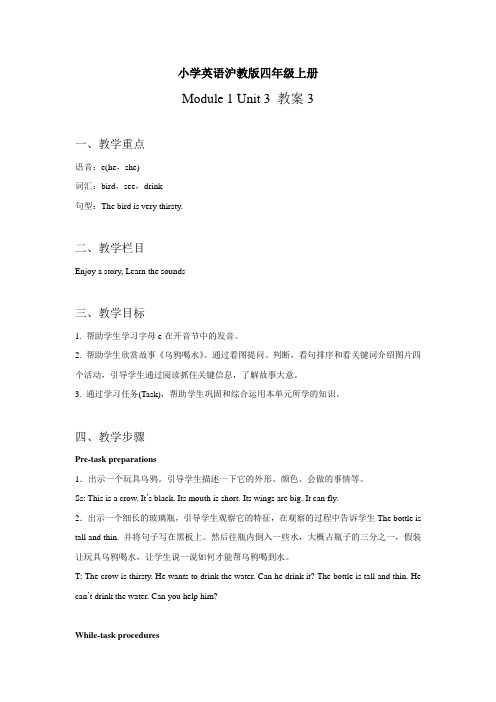
小学英语沪教版四年级上册Module 1 Unit 3 教案3一、教学重点语音:e(he,she)词汇:bird,see,drink句型:The bird is very thirsty.二、教学栏目Enjoy a story, Learn the sounds三、教学目标1. 帮助学生学习字母e在开音节中的发音。
2. 帮助学生欣赏故事《乌鸦喝水》。
通过看图提问、判断,看句排序和看关键词介绍图片四个活动,引导学生通过阅读抓住关键信息,了解故事大意。
3. 通过学习任务(Task),帮助学生巩固和综合运用本单元所学的知识。
四、教学步骤Pre-task preparations1.出示一个玩具乌鸦。
引导学生描述一下它的外形、颜色、会做的事情等。
Ss: This is a crow. It’s black. Its mouth is short. Its wings are big. It can fly.2.出示一个细长的玻璃瓶,引导学生观察它的特征,在观察的过程中告诉学生The bottle is tall and thin. 并将句子写在黑板上。
然后往瓶内倒入一些水,大概占瓶子的三分之一,假装让玩具乌鸦喝水,让学生说一说如何才能帮乌鸦喝到水。
T: The crow is thirsty. He wants to drink the water. Can he drink it? The bottle is tall and thin. He can’t drink the water. Can you help him?While-task procedures1.把挂图贴在黑板上,针对Enjoy a story的图片提问,启发学生思考,初步了解故事大意。
1) What season is it? (It’s summer.)2) How does the bird feel? (He’s thirsty.)3) Can he drink the water in the bottle? (Yes, he can.)2.播放Enjoy a story的故事录音,然后要求学生读故事。
小学英语沪教版四年级上册Module3 Places and activities《Revision 3》公开课教案教师资格证面试试讲教案
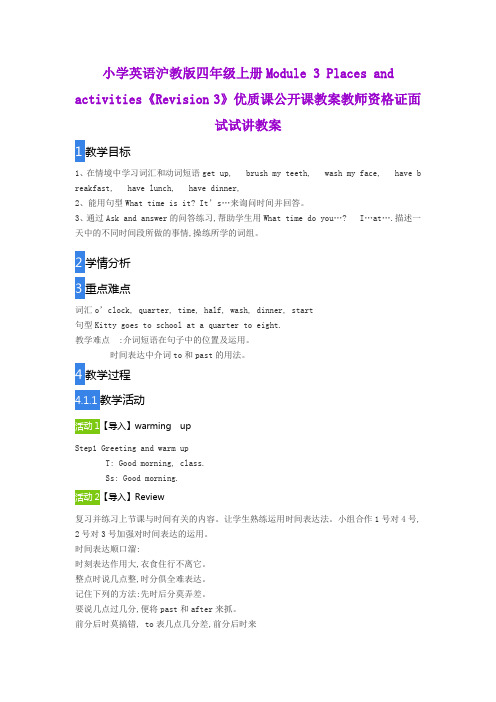
小学英语沪教版四年级上册Module 3 Places and activities《Revision 3》优质课公开课教案教师资格证面试试讲教案1教学目标1、在情境中学习词汇和动词短语get up, brush my teeth, wash my face, have b reakfast, have lunch, have dinner,2、能用句型What time is it? It’s…来询问时间并回答。
3、通过Ask and answer的问答练习,帮助学生用What time do you…? I…at….描述一天中的不同时间段所做的事情,操练所学的词组。
2学情分析3重点难点词汇o’clock, quarter, time, half, wash, dinner, start句型Kitty goes to school at a quarter to eight.教学难点:介词短语在句子中的位置及运用。
时间表达中介词to和past的用法。
4教学过程4.1.1教学活动活动1【导入】warming upStep1 Greeting and warm upT: Good morning, class.Ss: Good morning.活动2【导入】Review复习并练习上节课与时间有关的内容。
让学生熟练运用时间表达法。
小组合作1号对4号, 2号对3号加强对时间表达的运用。
时间表达顺口溜:时刻表达作用大,衣食住行不离它。
整点时说几点整,时分俱全难表达。
记住下列的方法:先时后分莫弄差。
要说几点过几分,便将past和after来抓。
前分后时莫搞错, to表几点几分差,前分后时来。
2019-2020年四年级英语上册 Unit 3教案 上海新世纪版
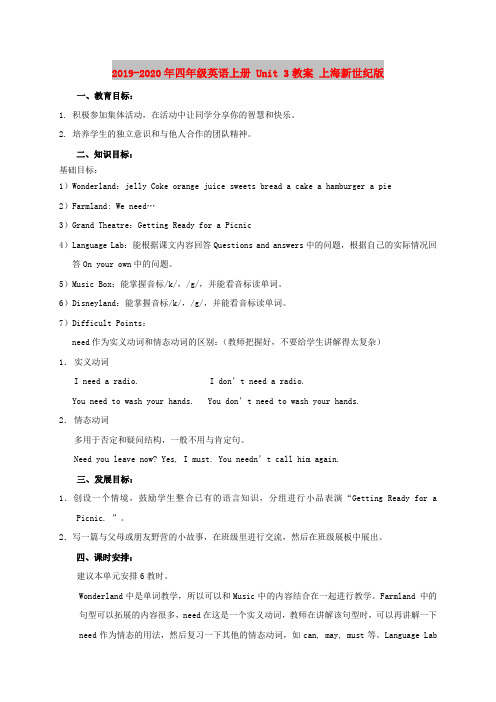
2019-2020年四年级英语上册 Unit 3教案上海新世纪版一、教育目标:1. 积极参加集体活动,在活动中让同学分享你的智慧和快乐。
2. 培养学生的独立意识和与他人合作的团队精神。
二、知识目标:基础目标:1)Wonderland:jelly Coke orange juice sweets bread a cake a hamburger a pie2)Farmland: We need…3)Grand Theatre:Getting Ready for a Picnic4)Language Lab:能根据课文内容回答Questions and answers中的问题,根据自己的实际情况回答On your own中的问题。
5)Music Box:能掌握音标/k/,/g/,并能看音标读单词。
6)Disneyland:能掌握音标/k/,/g/,并能看音标读单词。
7)Difficult Points:need作为实义动词和情态动词的区别:(教师把握好,不要给学生讲解得太复杂)1.实义动词I need a radio. I don’t need a radio.You need to wash your hands. You don’t need to wash your hands.2.情态动词多用于否定和疑问结构,一般不用与肯定句。
Need you leave now? Yes, I must. You needn’t call him again.三、发展目标:1.创设一个情境,鼓励学生整合已有的语言知识,分组进行小品表演“Getting Ready for a Picnic. ”。
2.写一篇与父母或朋友野营的小故事,在班级里进行交流,然后在班级展板中展出。
四、课时安排:建议本单元安排6教时。
Wonderland中是单词教学,所以可以和Music中的内容结合在一起进行教学。
Farmland 中的句型可以拓展的内容很多,need在这是一个实义动词,教师在讲解该句型时,可以再讲解一下need作为情态的用法,然后复习一下其他的情态动词,如can, may, must等。
新沪教牛津版四年级上Unit 3 Are you happy教案
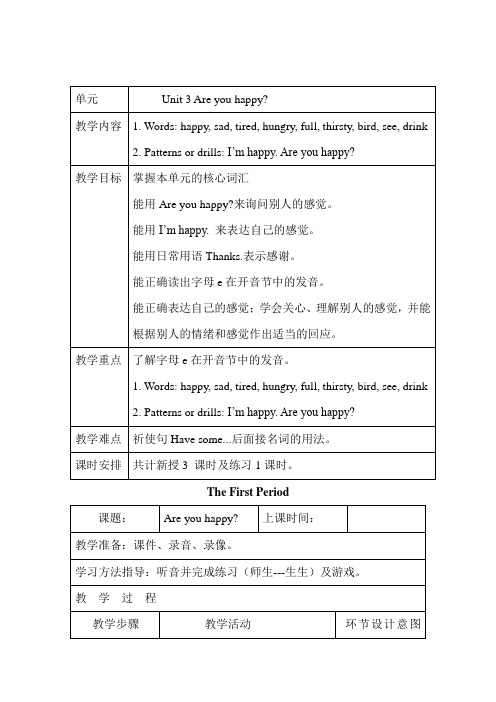
The First PeriodThe Second PeriodThe Third PeriodThe Fourth PeriodUnit 5 Animals in dangerTeaching Aims(教学目标):1.能听、说、读、写本课的核心词汇:thousand, hundred, wild, way, die, learn, send, in danger, in the past, take care of2.能熟练掌握核心句型:In the past, there were many pandas.What can we do to help them?3.知道动物是人类的朋友,人类应该和动物建立良好的关系,要保护动物。
Teaching Importances and Difficulties (教学重难点):1.能在语境中正确运用本单元的核心词汇。
2.用There was/were …对某种东西的数量进行陈述。
3.了解字母u及字母组合ue、oo在单词中的发音规律,拼读简单的单词。
Teaching Tools(教学用具):录音机、自制课件、照片等Teaching Procedures(教学过程):StepⅠ. Warm up and revision(热身与复习)1. Sing a song.2. Play a game: Apple tree3. Count the numbers together.Step Ⅱ. Presentation and practice (自主探究)1. 生词关T: Please write the meanings on your paperthousand______ hundred______ wild________only________ about______ whale _________am/is_______(过去式) are______(过去式)2. T:Show the pictures and learn the new words: thousand, hundredSs:Read these words after teacher.3. Work in groups to read the new words. Recite the new words, then recite in groups。
Module3Unit3Intheshop(教学设计)牛津上海版(试用本)英语四年级上册
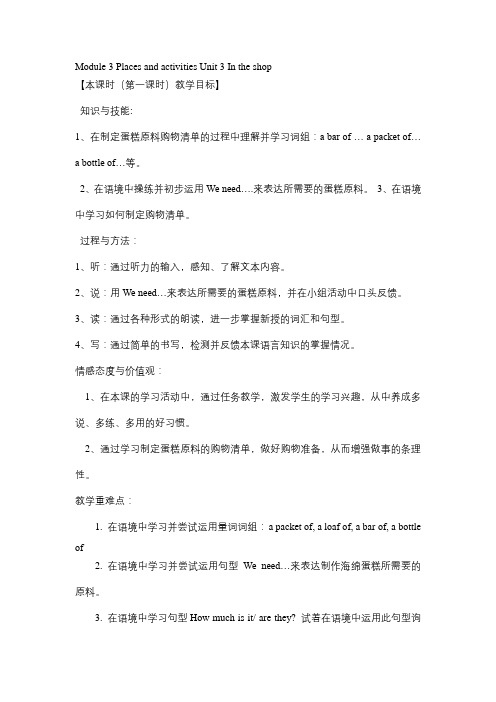
Module 3 Places and activities Unit 3 In the shop【本课时(第一课时)教学目标】知识与技能:1、在制定蛋糕原料购物清单的过程中理解并学习词组:a bar of … a packet of…a bottle of…等。
2、在语境中操练并初步运用We need….来表达所需要的蛋糕原料。
3、在语境中学习如何制定购物清单。
过程与方法:1、听:通过听力的输入,感知、了解文本内容。
2、说:用We need…来表达所需要的蛋糕原料,并在小组活动中口头反馈。
3、读:通过各种形式的朗读,进一步掌握新授的词汇和句型。
4、写:通过简单的书写,检测并反馈本课语言知识的掌握情况。
情感态度与价值观:1、在本课的学习活动中,通过任务教学,激发学生的学习兴趣,从中养成多说、多练、多用的好习惯。
2、通过学习制定蛋糕原料的购物清单,做好购物准备,从而增强做事的条理性。
教学重难点:1. 在语境中学习并尝试运用量词词组:a packet of, a loaf of, a bar of, a bottle of2. 在语境中学习并尝试运用句型We need…来表达制作海绵蛋糕所需要的原料。
3. 在语境中学习句型How much is it/ are they? 试着在语境中运用此句型询问价格,并能用句型It’s/They’re… 进行回答。
i.e. How much is it? It’s twelve yuan, please. How much are they? They’re five yuan, please.4. 在语境中学习如何制作一个海绵蛋糕,并能用恰当的动词进行简单描述。
i.e. put, stir, pour, bake5. 学习辅音连缀/sm/, /sp/, /st/,并了解其在单词中的发音情况。
i.e. smoke, spider, star教学过程。
新牛津沪教四年级上册module 3《unit 3 a class picnic》period4优秀教案(重点资料).doc
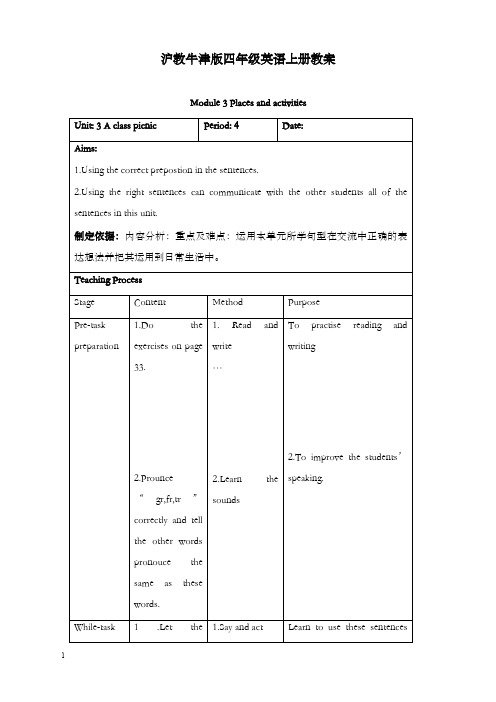
Teaching Process
Stage
Content
Method
Purpose
Pre-task preparation
1.Do the exercises on page 33.
2.Prounce“gr,fr,tr”correctly and tell the other words pronouce the same as these words.
2.Listen to the tape and repeat after the tape
1.Say and act
2.Read it in the whole class then check it
Learn to use these sentencesproperly in the life.
板书:
in on under
Thinking & Rebuilding
practise the listening and reading.
Post-task activity
Finish the exercises papers
1.Do the work,
then check it
1.To
practice what they have learned in this unit..
沪教牛津版四年级英语上册教案
Module 3 Places and activities
Unit: 3 A class picnic
Period: 4
Date:
Aims:
ing the correct prepostion in the sentences.
小学英语沪教版四年级上册Unit3Areyouhappy教案1
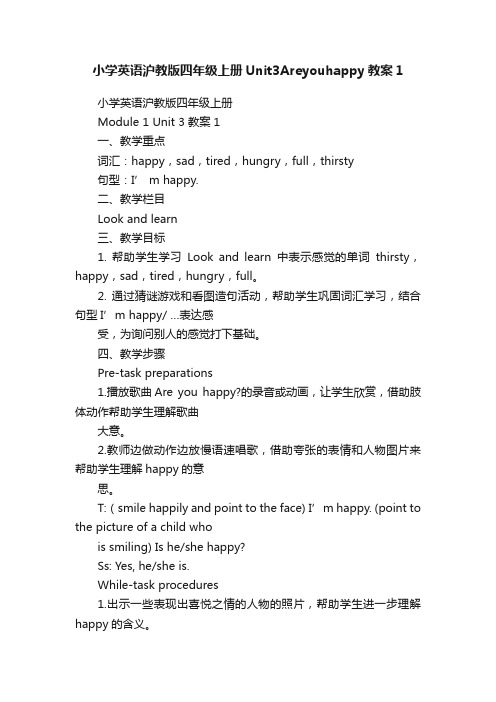
小学英语沪教版四年级上册Unit3Areyouhappy教案1
小学英语沪教版四年级上册
Module 1 Unit 3 教案1
一、教学重点
词汇:happy,sad,tired,hungry,full,thirsty
句型:I’ m happy.
二、教学栏目
Look and learn
三、教学目标
1. 帮助学生学习Look and learn中表示感觉的单词thirsty,happy,sad,tired,hungry,full。
2. 通过猜谜游戏和看图造句活动,帮助学生巩固词汇学习,结合句型I’m happy/ …表达感
受,为询问别人的感觉打下基础。
四、教学步骤
Pre-task preparations
1.播放歌曲Are you happy?的录音或动画,让学生欣赏,借助肢体动作帮助学生理解歌曲
大意。
2.教师边做动作边放慢语速唱歌,借助夸张的表情和人物图片来帮助学生理解happy的意
思。
T:(smile happily and point to the face) I’m happy. (point to the picture of a child who
is smiling) Is he/she happy?
Ss: Yes, he/she is.
While-task procedures
1.出示一些表现出喜悦之情的人物的照片,帮助学生进一步理解happy的含义。
四年级英语上册Module3Unit3Aclasspicnicperiod4教案沪教牛津版
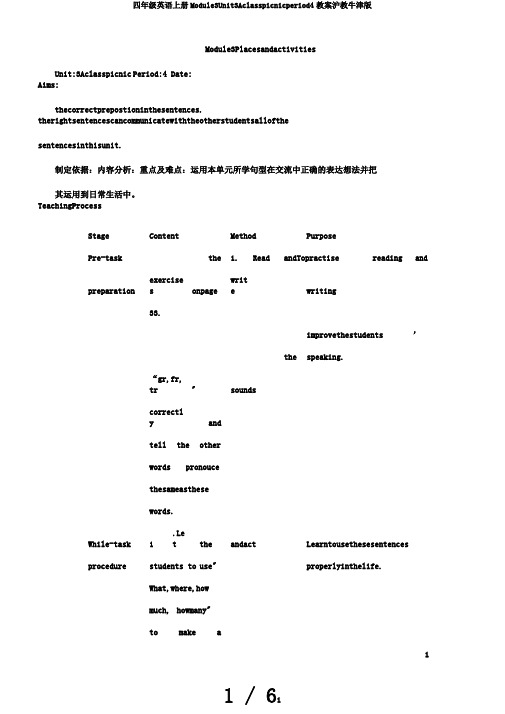
Module3PlacesandactivitiesUnit:3Aclasspicnic Period:4 Date:Aims:thecorrectprepostioninthesentences. therightsentencescancommunicatewiththeotherstudentsallofthesentencesinthisunit.制定依据:内容分析:重点及难点:运用本单元所学句型在交流中正确的表达想法并把其运用到日常生活中。
TeachingProcessStage Content Method PurposePre-task the 1.Read andTopractise reading andpreparation exercises onpagewrite writing33.improvethestudents’the speaking.“gr,fr,tr〞soundscorrectly andtell the otherwords pronoucethesameasthesewords.While-task1.Let the andact Learntousethesesentencesprocedure students to use〞properlyinthelife.What,where,howmuch,howmany〞to make a1dialoguepractise the listening andit inthe reading.whole classto the thencheckittape and repeatafterthetapePost-task Finish thework,activity exercisespapers thencheckit practice what they havelearnedinthisunit..板书:inonunderThinking &Rebuilding两年前的某个早上,开完科会,主任迷之微笑地对我说了一句话,啊勉,从明天开始,你每天发一句英语让大家读。
沪教版四年级上学期英语Unit 3 Are you happy 教案

6.T:I do a lot housework.I’m tired.将单词写在黑板上,学生拼读.
Ss: We….. a lot. We’re tired.
7.连线。
Post-task activities
1.头脑凤暴。要求学生四人一组讨论:在什么情况下会感到happy/sad/hungry/thirsty,在这些时候喜欢做什么。
作业
设计
第一课时
1.Listen to the tape and read the words three times, then try to remember them.
2.抄写单词thirsty, happy, sad, tired, hungry, full
第二课时
1.Listen to the tape and read the dialogue three times, then try to recite it.
S2:Howareyou ?
S1:I amhappy.
3.写一写。之后和同学们交流。
当堂达标设计
填入相对应的词
I’m.
Howyou feel , Danny ?
A: I’m.
教学反思
现象与归因分析
改进措施
教学设计首页
课题
Unit 3 Are you happy?
课型
Teaching
课时
2nd
授课时间
3.复述故事.
课时划分与分课时目标
板块
单元知识
整合与拓展的知识
教学目标
主题语境
第一课时
look and learn
- 1、下载文档前请自行甄别文档内容的完整性,平台不提供额外的编辑、内容补充、找答案等附加服务。
- 2、"仅部分预览"的文档,不可在线预览部分如存在完整性等问题,可反馈申请退款(可完整预览的文档不适用该条件!)。
- 3、如文档侵犯您的权益,请联系客服反馈,我们会尽快为您处理(人工客服工作时间:9:00-18:30)。
新世纪版四年级英语上册Unit 3 Getting Ready for a Picnic一、教育目标:1. 积极参加集体活动,在活动中让同学分享你的智慧和快乐。
2. 培养学生的独立意识和与他人合作的团队精神。
二、知识目标:基础目标:1)Wonderland:jelly Coke orange juice sweets bread a cake a hamburger a pie2)Farmland: We need…3)Grand Theatre:Getting Ready for a Picnic4)Language Lab:能根据课文内容回答Questions and answers中的问题,根据自己的实际情况回答On your own中的问题。
5)Music Box:能掌握音标/k/,/g/,并能看音标读单词。
6)Disneyland:能掌握音标/k/,/g/,并能看音标读单词。
7)Difficult Points:need作为实义动词和情态动词的区别:(教师把握好,不要给学生讲解得太复杂)1.实义动词I need a radio. I don’t need a radio.You need to wash your hands. You don’t need to wash your hands.2.情态动词多用于否定和疑问结构,一般不用与肯定句。
Need you leave now? Yes, I must. You needn’t call him again.三、发展目标:1.创设一个情境,鼓励学生整合已有的语言知识,分组进行小品表演“Getting Ready for a Picnic. ”。
2.写一篇与父母或朋友野营的小故事,在班级里进行交流,然后在班级展板中展出。
四、课时安排:建议本单元安排6教时。
Wonderland中是单词教学,所以可以和Music中的内容结合在一起进行教学。
Farmland 中的句型可以拓展的内容很多,need在这是一个实义动词,教师在讲解该句型时,可以再讲解一下need作为情态的用法,然后复习一下其他的情态动词,如can, may, must等。
Language Lab 是Grand Theatre的配套练习,所以应该结合在一起进行教学。
Disneyland中的内容是一首小诗,所以可以放在每一节课之前进行诵读,让学生自然习得,教师也可以找一些课外的儿歌补充教学内容。
五、教法建议:一)词汇教学方法1.)教师可用媒体或图片创设情境引出本课的单词。
Tommy: Hong Wei, are you free this weekend?Hong Wei: Yes, I have no lessons on that day.Tommy: Would you like to have a picnic with me?Hong Wei: Yes, l’d love to. But we should get ready for it now.Tommy: Yes, what do we need?Hong Wei: I need a cake and orange juice. How about you?Tommy: I need Coke, sweets.Hong Wei: What else?Tommy: I need jelly and a pie. I need bread and a hamburger.Hong Wei: Oh, you need a big bag first!画面与对话相配合,当出现新授词汇jelly, Coke, orange juice, sweets, bread, a cake,a pie, a hamburger时,画面特写出这些单词的图片。
2)教师可反复让学生听几遍对话,让学生自然习得一些词汇。
随后教师可出示图片让学生快速反应说出单词,对于学生尚没有掌握的单词或发音不正确的单词,教师示范,让学生仿说。
在学生基本掌握了语音和语义后,教师可通过如下方式帮助学生关注词形,巩固词形和语义之间的联系。
教师可出示若干购物清单, 让学生读一读,看看少了什么。
例如3)随后教师可让学生完成Language Lab 中的第一部分Choose, write and spell 的练习来帮助学生巩固单词的拼写。
o a i e ea ee gep___ e c ___ke br ___ d h ___mburgersw___ ts j ___ lly C___ ke oran___4)教师可组织学生做“Who has the best appetite?”的游戏来帮助学生巩固和积累词汇,提高词汇学习的趣味性。
例如:T:What do you want to eat for picnic?P1: I need some sweets.P2: I want some sweets and a pie.P3: I would like some sweets, a pie and a Coke.P4: I need some sweets, a pie, a Coke and a hamburger...在谈论到 jelly, bread, orange juice时,教师要提醒学生特别注意这些是不可数名词,即便前面用some来修饰,不可数名词也不能加复数。
5)最后教师可让学生表演上面的这段对话。
六、教法建议一)词汇教学方法1)教师可谈话引出Farmland中的小对话。
Tommy, Sue and Norman are going to have a Christmas party. Listen, what are they talking about?然后让学生听、仿说Farmland中的小对话,并用Farmland中给出的7个词汇模仿创编出新的小对话进行角色表演。
在替换练习,表演小对话的过程中掌握本单元的基本句型:表达需求的句子We need…及其提问What do you need?2)由于该基本句型在以前的几册教材中都出现过,学生较易掌握,因此建议教师可根据语言功能对句型进行扩充。
教师可用媒体或图片创设情境,从中引出表达需求的不同句型:I need …Give …, please.…, please.I’d like …I want …Narrator: Norman, Tim, Sue, Sandy, Julia and Peter are going autumn outing nextweek. They’ve got a lot of food in Mr White’s bag.Tim: I’m thirsty. Give me some orange juice, please.Mr White: OK, here you are.Norman: I’m thirsty, too. Give me a Coke, please.Mr White: OK, here you are.Sandy: I’m hungry. A hamburger, please.Mr White: OK, here you are.Julia: I’m hungry, too. I’d like some bread.Mr White: OK, here you are.Peter: I’m thirsty and hungry. I need some water and a cake.Mr White: OK, here you are.Sue: I’m thirsty and hungry, too. I want an apple and a pie, please.Mr White: There is only an apple pie!画面与对话相配合。
3)教师可让学生反复听几遍对话。
第一遍,只出现画面,不出现文字; 第二遍,出现对话的文字,主要句型用红色标注; 第三遍,教师可在观看对话的过程中引导学生仿说;第四遍,教师可在对话放到主要句型时,适时地将对话的音量调小,让学生配音,了解学生对主要句型的习得情况。
让学生在听、仿说中逐步习得表示需求的多种表达方式。
4)对于四年级的学生,教师还可帮助学生掌握该句型的第三人称单数形式。
教师可先让学生根据刚才的对话完成表格:然后可给出学生model, 让学生模仿例句完成句子。
Model : Tim is thirsty. He needs some orange juice.Julia is hungry. She needs some bread.Norman is _________. He __________.Sandy is ___________. He __________.Peter is ___________. He __________.Sue is _________. She __________.__________________. ____________________5)随后,教师可让学生完成Project 1 Making a Shopping List6)最后教师可让学生根据现实生活中的情境,整合已有的语言知识,自由创编和表演对话,让学生在尽可能生活化的语境中运用语言知识。
例如,教师可创设Birthday Party的情景。
二)课文教学方法1)教师可在Warming-up中让学生朗读Disneyland中的儿歌Hot Grey Peas, 然后自然引出下面的话题讨论。
What are they doing?What are they eating for the picnic?2)教师可先通过Language Lab中On your own中的问题让学生围绕着装展开话题讨论。
Do you like picnics?Where would you like to have a picnic?What do you need for your picnic?Have you got enough money for your picnic?在话题讨论中,教师可引出课文中的新句子What else?3)接着教师可从话题讨论中自然引出课文。
Children will have a picnic. What do they need?Have they got enough money for their picnic? Let’s listen.4)听完课文录音后,教师可通过让学生回答Language Lab的Questions and answers中的问题来了解学生对课文内容的理解程度。
